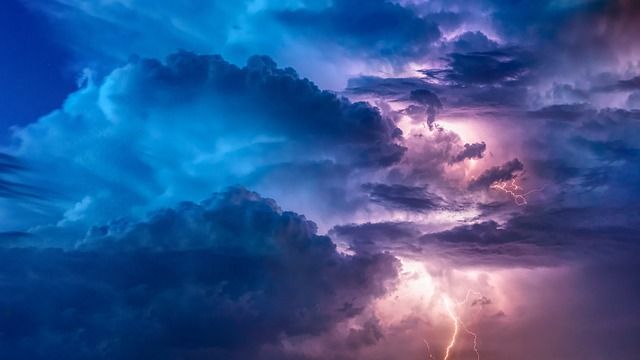Staying Safe in a Lightning Storm
Like tornadoes, lightning is best viewed at a distance. Here's how to stay safe when it gets up close and personal.

Staying Safe in a Lightning Storm
NOTE: Yes, this article is a bit late for summer 2023. However, we still have a couple of months perfect for thunderstorms and hurricanes. So, please read on!
Summer means being outside more frequently than during colder weather. While always enjoyable, one natural phenomenon can ruin anyone's day, lightning. Fortunately, following a few simple rules will reduce your chances of being hit by lightning to near zero.
NOAA defines lightning as a gigantic spark of electricity between clouds (intra-cloud) or between the clouds and ground (cloud-to-ground). According to an article from Science Shorts, lightning bolts are extraordinarily powerful, releasing 100 billion volts and 30,000. Compare that to ordinary household electricity at 120 volts and 15 – 50 amps.
There are a couple of crucial dangers from lightning—first, personal injury or death. The chances of being struck by lightning are about 1 in 15,300 over your lifetime. Tell that to Roy Cleveland Sullivan, a Park Ranger in the Shenandoah National Park. He was struck seven times, surviving each one. He has the dubious distinction of holding the Guinness Book of World Records for the feat.
The second danger area involves property damage. This includes structures and tall trees being struck and household appliances and electronics. That said, you have options for protecting your property and electronics with surge protection, proper grounding, and lightning rods, if necessary.
We can't overstate the importance of knowing how to stay safer in a lightning storm. The National Weather Service reports that only 10% of lightning strike victims die. The survivors invariably suffer serious injuries. However, the number of deaths is declining, dropping from 43 per year to 27 today. We attribute the decline to lightning safety awareness.
Lightning Basics
Going back to NOAA, lightning occurs when opposing electrical charges develop between clouds or between clouds and the ground. The air acts as insulation until the charge overwhelms it, releasing a lightning bolt. The breakdown between cloud-to-cloud (CC) and cloud-to-ground (CG) is 25/75%.
Tall objects attract lightning, explaining why you shouldn't seek shelter under a tree. However, specific geographic areas around the globe are lightning magnets. Examples include the area above Lake Maracaibo in Venezuela (250 strikes/square kilometer/year) and the village of Kifuka in the Democratic Republic of the Congo (232 strikes/square kilometer/year). You can read more about the distribution of lightning on Wikipedia. Here's a graphic from that article showing lightning strike density worldwide.

Citation: Distribution of lightning. (July 22, 2023). In Wikipedia. https://en.wikipedia.org/wiki/Distribution_of_lightning
After a lightning strike, the electricity imparted flows down or along the struck object towards the nearest and best ground. This characteristic presents another danger beyond being hit directly. Being near a struck object can expose you to the electricity flowing from the strike point to the ground. We'll talk about how to protect yourself from this shortly.
If you want to see a real-time map of lightning strikes in the US, check out lightningmaps.org.
Lightning Safety Before a Storm
Awareness is your best defense against lightning, especially outdoors. Before going out to swim, golf, hike, or otherwise enjoy the summer weather. Outfit your smartphone with a weather app and one for lightning detection/reporting. Please pay attention to them during the day so you can take steps to remain safe in a storm.
When to get to your destination, look around and identify safe locations. These include covered pavilions, snack bars, open equipment storage sheds, under traffic bridges, visitor centers, etc. They should also avoid conductive materials like chain link fences and lighting masks. If you are in a location without any shelter, look for depressions and dry ditches where you can reduce your "attractiveness" to lightning.
Your vehicle offers a safer option than hanging around unprotected if you can reach it quickly. Your vehicle can be a safe haven with its rubber tires acting as insulators. Just stay below the windows as much as possible.
The old rule of thumb says counting between seeing a lightning flash and hearing the thunder will tell you the miles to the storm. Lightning can travel between 5 and 10 miles before striking the ground. So, once you see a flash, start counting. If you don't reach a ten-count, consider moving to safety.
Lightning Safety During a Storm
Outdoors
If a storm catches you outside, head for your pre-identified shelter and wait until it passes. In cases where there aren't any places to shelter, and you cannot reach your car, head for the nearest depression or ditch. Once in position, crouch down in a catcher's stance. You'll likely recall previous safety tips advising you to lay flat. That's a bad tactic because of how the electricity flows through the ground.
Here's why lying flat exposes you to danger. The electricity from the lightning strike flows through the ground, following differences in electrical potential. If you lie flat, your body creates a differential attracting electricity. The solution involves the crouching position. You want to keep your feet shoulder-width apart and side-by-side. This eliminates or dramatically reduces the potential you create, keeping you safer.
Indoors
So, do you need to take any special precautions while inside during a storm? Yes, but as you'd guess, they are more straightforward. Here's the recap:
- The first rule of indoor safety is staying away from windows.
- Next, don't shower, bathe, or use the restroom during the storm. If lightning strikes your home, the plumbing will attract electricity.
- Stay off hardwired telephones and cordless phones. Again, if lightning strikes your house, it can follow the telephone wiring and injure you. But why stay off cordless phones? Because, in rare instances, they can attract lightning, ask my sister-in-law.
- Turn off your high-value electronics. This won't completely protect them, but it does reduce the chances of damage. There are also cases where lightning strikes a satellite dish. In one instance, the dish was mounted on a pole away from the home. However, the lightning followed the dish cable and blew up the television, which was on during the storm. Needless to say, the homeowner was unpleasantly surprised.
Conclusion
Paying proper attention to your surroundings when outside and taking precautionary steps inside can relegate lightning to an awe-inspiring display of Mother Nature's fireworks.
